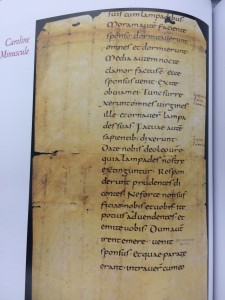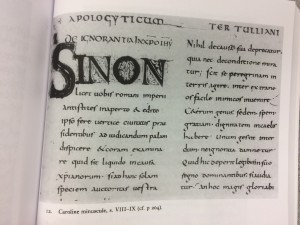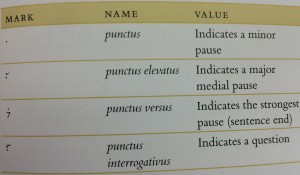After checking out Kendall Piccollo's post on the history and background of the Caroline (also called Carolingian) Minuscule script (found under the "Historical Background" section here: https://sites.dartmouth.edu/ancientbooks/2016/05/24/carolingian-miniscule/), you may be interested in the finer points on how to write the letters and how to properly produce the text. In this post, I will provide a few tips and tricks through images and videos on how to write Caroline Minuscule.
There are four major defining characteristics about Caroline Minuscule that stand out immediately from other, older, texts: the first thing to notice is that Caroline Minuscule is written with spaces in between the words. Caroline Minuscule is one of the first scripts to have spacing between the words, as opposed to "scriptio continua," or without spacing. The second defining characteristic is that Caroline Minuscule has ascenders and descenders; that is, portions of some of the letters either extend above the median line or descend below the baseline, similar to our modern minuscule English (think b or h for ascenders, and q or p for descenders). These ascenders and descenders help increase the recognizability of the script. This also means that Caroline letters will vary in height - something that will be explained in the videos below and something that will be important in laying the out vertical spacing on the rows of your script. The third major characteristic of the script is the Uncial letter at the beginning of each major section, paragraph, or sentence (to learn more about the paleography of Uncial, check out this post: https://sites.dartmouth.edu/ancientbooks/2016/05/25/uncial-half-uncial/#more-59). When writing in prose, this usually meant starting off an important section such as a paragraph break or the start of a sentence with one of these letters. When writing in poetry, this usually meant starting off every line of poetry with a large Uncial or Half Uncial letter (note: this means every line of the poetry that you are copying, not every line of the script that you are writing out). The final characteristic is that Caroline Minuscule uses a number of different punctuation marks; something that you will notice in all of the following examples and that will be explained in greater depth later on in the post. The picture below entitled "Caroline Minuscule Image #1" is a particularly good encompassing example of all of these traits.
Here are a couple of additional historical Caroline Minuscule script examples for you to get familiar with the text format and lettering (click on the images to enlarge them if the text is too small to read here):
Caroline Minuscule Image #1

Source: "Adoption of the Carolingian Minuscule Brought the Destruction of Many Late Roman Manuscripts" from HistoryofInformation.com (http://www.historyofinformation.com/expanded.php?id=2907), last updated May 19, 2016. Last accessed May 23, 2016.
Caroline Minuscule Image #2
Source: Clemens, Raymond and Timothy Graham. Introduction to Manuscript Studies. Ithaca & London: Cornell University Press, 2007. Image taken from page 142. Caption reads: "10-4 Newberry Library, Medieval Manuscript Fragment 3, verso (254 x 155 mm).
Note: Each line or important section may not start with an Uncial or Half Uncial letter, but each sentence starts with a Carolingian Majuscule letter, which is essentially the upper case version of Caroline Minuscule - another lesson for a different post!
Caroline Minuscule Image #3
Source: Bischoff, Bernhard. Latin Paleography: Antiquity & the Middle Ages, translated by Daibhi O Croinin & David Ganz. Image taken from "Plate 12." Caption reads: Caroline Minuscule, s. VIII-IX.
Note: the consistent spacing between the words, the use of punctuation, the large beginning letters indicating the start of a paragraph or new section, and the relatively large spacing between each row to allow for variations in height of the letters.
Practice the Script
Once you have studied the form of the script and referenced historic examples to get a general feel for what Caroline Minuscule looks like, you should begin practicing the script on your own. There are numerous examples of "Caroline Minuscule" that you might find on the web with a simple "Google" search, but not all of those images and videos can be reliable. Here are a few videos that can help guide you to look for what Caroline Minuscule should look like:
In this fist video that I made, I attempt to outline the very bare basics on how to write the text. You do not need to follow my example to the letter, but it should be a useful starting point in creating your own unique version of the script:
Example Script #1
This second example video, entitled "Carolingian Minuscule," gives you a very concise, yet useful, example of how to write the script:
Example Script #2
Source: "Carolingian Minuscule Calligraphy" by user Marlo Sudaria. https://www.youtube.com/watch?v=KLgPDyL7WRk. Published on April 12, 2016. Last accessed May 23, 2016.
Note some of the differences here between my script:
- This author uses a "J," and a "W". As I point out in my video, it's up to you what those letters might look like but these are some good examples.
- The author writes out a modern minuscule "s", and then an "s" that resembles more of the versions that I used in my video.
- The author does show some of the variations of some of the letters that I point out in my video; however, it looks like the letters in this video are essentially the most "standard" forms that I lay out in the video above.
In this last example video, the author similarly explains some of the key tips and examples for writing the text:
Example Script #3
Source: "Carolingian" by user Reggie Ezell. https://www.youtube.com/watch?v=BUhIyiJJxCM. Published on February 14, 2014. Last accessed May 23, 2016.
Some things to note in this video:
- Again, there are slight variations on the letters; not everyone's handwriting will be the same!
- The author brings up a good point in the beginning of the video that I touch on in the first video above: it is useful to keep your pen tip at a 30 degrees angle to the paper while you write the script as this will help you to create that distinctive forward-leaning pen stroke that is a characteristic of Caroline Minuscule.
- Notice how the author starts to conjoin some of his letters, flowing from one to another like modern script. If you look back to the earlier image examples, you will see that the scribes who wrote those texts did something very similar. This may help you write faster as you get more efficient with practice, and it might also help you to distinguish between words as you get a handle for the spacing.
Punctuation and Abbreviation
As noted earlier, the use of consistent punctuation marks is a defining characteristic of Caroline Minuscule, and the script is one of the first ones to use a variety of complex punctuation and abbreviation marks periodically. You can reference the images above for more hands-on examples of what these marks look like and what they might be used to indicate, but the image below should give you a basic idea for the form and function of each commonly used mark:
Source: Clemens, Raymond and Timothy Graham. Introduction to Manuscript Studies. Ithaca & London: Cornell University Press, 2007. Image taken from page 85.
The image is fairly self explanatory, but the marks are typically used as follows:
- the first mark is for a comma.
- the second mark could be used for a semi colon, or any other similarly strong pause in the sentence.
- As indicated in the image, the third mark is used as a period.
- Again, as it suggests in the image, the fourth mark would be used as a question mark.
Try to incorporate these punctuation and abbreviation marks into your writing as you practice the script.
Thank you for reading my post and I hope that you find all of the information on here useful. There are plenty of other resources online that you can find, but be mindful of which resources you rely on as a simple "Google" search might get you into trouble in terms of the integrity of the script. I also encourage you to view the other posts in this blog if you would like to compare and contrast Caroline Minuscule with other types of scripts or if you would like to learn more about the various ancient book-making processes.



Pingback: Carolingian Minuscule – Hannah Parvi
Thank you for this fascinating and practical entry. I'm a Dartmouth '81 novelist just finishing and checking some details on Merovingian and Carolingian for the continuation of my series, which features characters who are fond of ancient hands. Great to see this knowledge passed on in such an intelligent way!
How were the capitol letters written in Caroline (Carolingian) Minuscule?